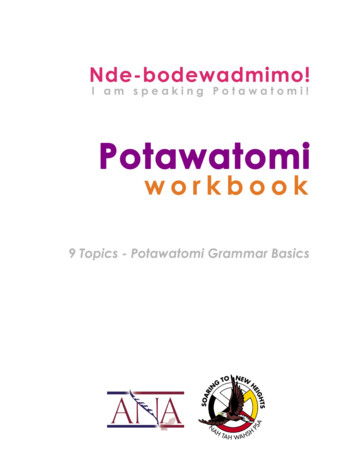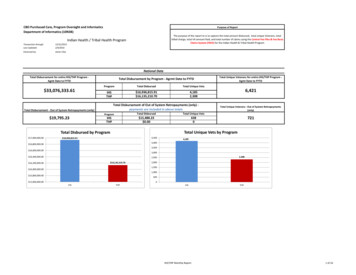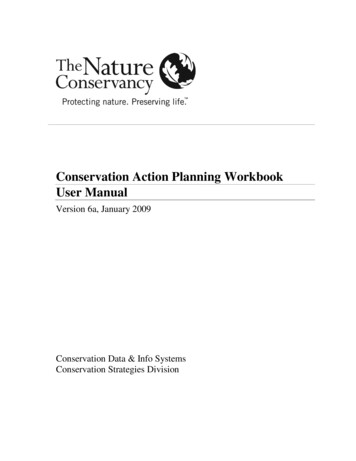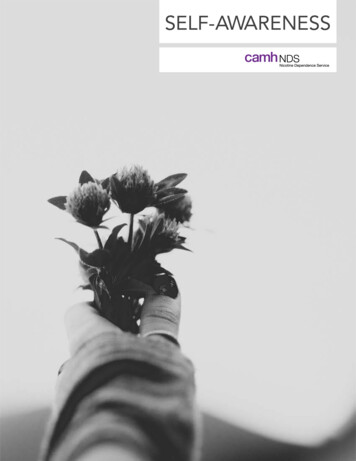
Transcription
Migwetth!We would like to thank Jim Thunder, Justin Neely, Earl Meshigaud, Kim Wensaut, Gail Belling,Forest County Potawatomi, Citizen Band Potawatomi, Laura Buzzard Welcher and any otherswho have contributed directly or indirectly to this workbook.This workbook is a production of the Hannahville Culture, Language and History Departmentand was compiled and edited by Eric Janofski for use in the high school classroom.This workbook is funded by:The ANA Digital Connection ProjectHannahville Indian SchoolNde-Bodewadmimo 3rd Edition Copyright 2009Hannahville Culture Language and History DepartmentPotawatomi Grammar Basics2
Potawatomi Grammar BasicsTable of ContentsUNIT 1 - Potawatomi BasicsChapter 1 - The Alphabet and PronunciationPg. 5 -- The Potawatomi Alphabet - Jim ThunderPg. 8 -- gigabe, gigyago, nene, kwe, mko, waboso, wdabyan, wigwam, mbagen, pedyebwenChapter 2 - Pronunciation and DialectsPg. 10 -- Pronunciation of vowels with certain consonantsPg. 12 -- Dialect DifferencesPg. 13 -- neshnabe, kekyat, penoje, penojes, seksi, nemosh, mayos, espen, wzhebyegen, pkwakwetChapter 3 - Basic ConversationPg. 15 -- Greetings, How do you do, Introductions, GoodbyePg. 19 -- bosho, haw, ahaw, ni tthe na, gin je, bama, bama pi, bama mine, i she anwe, zhenkasoChapter 4 - Introduction to NounsPg. 21 -- Animate and Inanimate NounsPg. 22 -- Singular and Plural NounsPg. 24 -- nitawes, moewe, kno, bsheke, kokosh, mzenegen, deschegen, dopwen, waboyan, gwabegasChapter 5 - DemonstrativesPg. 26 -- DemonstrativesPg. 27 -- More on AnimacyPg. 28 -- sema, nen sema, wishgbemishgos, kishge, wabshkebyak, shkemot, sema shkemot, zhabnegen,sebabis, mdomnesChapter 6 - Verb ConjugationPg. 30 -- Verb ConjugationPg. 33 -- Short and Long ConjugationPg. 34 -- bekte, depseni, wisne, mikchewi, chikazo, zhye, maji, bye, bmose, bmeptoPotawatomi Grammar Basics3
Chapter 7 - Word OrderPg. 36 -- Word Order, wde-ton and wde-saPg. 37 -- Negative Word OrderPg. 38 --Yes/No Questions with NePg. 40 -- wde-ton, wde-san, mine, anake, nekdosha, peneshi, otthedemo, getemi, biskowagen, wiwkwanChapter 8 - Asking QuestionsPg. 42 -- Yes/No Question and Question WordsPg. 44 -- wi ni tthe, ni tthe, weg wni tthe, ni tthe pi, ni pi tthe, ni tthe tse, mtek, sen, msen, mishgosChapter 9 - CommandsPg. 46 -- Commands, Prohibitive CommandsPg. 48 -- Zhenkaso ReviewPg. 49 -- majin, byan, zhyan, dokin, binchegen, dapnen, nibwen, tthibedeben, zhode, ibeGlossaryPg. 51 -- Glossary of vocabulary words.Potawatomi Grammar Basics4
Chapter 1 - The Alphabet and PronunciationCHAPTER 1The Alphabet and PronunciationLet’s begin with the most basic aspect of any language, the alphabet and pronunciation. The material belowdescribes how the Potawatomi vowels and consonants are pronounced. If you understand the alphabet, speakingPotawatomi from written sources will be very simple.The following is an excerpt from Jim Thunder’s Old Potawatomi Language Book, Ngot.VowelsThe Potawatomi language consists of the following vowels: A – E – I – O. These vowels are used in every part ofthe Potawatomi word or sentence to create the needed sounds. Each of these vowels has only one sound and thusare used with any letter or a combination of letters to produce any sound in the Potawatomi language.It is important to remember the one vowel – one sound concept when reading the old Potawatomi writings.Although the English alphabet is used, the sounds of each letter are totally different. The four vowels themselvesare used with certain letters of the English alphabet to form the Potawatomi alphabet. Before we get into thePotawatomi alphabet we must first learn the sounds of the four vowels.A – is pronouncedahas in awningE – is pronouncedehas in elmI – is pronouncedeeas in easelO – is pronouncedohas in openConsonantsSince the vowels A – E – I – O appear with every consonant of the Potawatomi alphabet these have been omittedas separate sounds. After we have gone through the Potawatomi alphabet we will then put some sentencestogether and study some actual Indian writings.BBaBeBiBoBa – as in bahBe – as in betBi – as in BeeBo – as in boat(In some of the old Indian writings, the letter L is used for the B sound)DDaDeDa – as in dawnDe - as in denGHDiDi – as in deeDoDo – as in doeGaGeGiGa – as in gallGe – as in getGi – as in geek Go – as in goHaHeHiHoHa – as in hallHe – as in hellHi – as in heelHo – as in hoePotawatomi Grammar BasicsGo5
Chapter 1 - The Alphabet and PronunciationTthKTthaTtheTthiTthoTtha – as in jawThe – as in JennyTthi – as in JeanTtho – as in JoeTtha – as in chalkThe – as in checkTthi – as in cheatTtho – as in choKaKeKiKoKa – as in kaw Ke – as in Ken Ki – as in keyMNKo – as in KolaMaMeMiMa – as in mamaMe – as in men Mi – as in meNaNeMoMo – as in moreNiNoNa – as in naw Ne – as in neck Ni – as in kneel No – as in noPPaPePa – as in Paul Pe – as in petPiPi – as in peePoPo – as in pole(Here again, some writers use the L to signify the P sound)STWSaSeSiSoSa – as in sawSe – as in setSi – as in seeSo – as in soTaTeTiToTa – as in talkTe – as in tenTi – as in teeTo – as in toeWaWeWiWoWa – as in want We – as in wet Wi – as in weed Wo – as in woeYYaYeYa – as in yacht Ye – as in yetYiYi – as in yieldYoYo – as in yo-yoC – In writings by anthropologists and others, C is used to signify the S sound.Q – Although some Indian writings use the letter Q, most of the Q sounds are made with the letters KW.U – The vowel U does not seem to be used very much in the Potawatomi language.X – I have not found the letter X used at all in any of my Indian writings.Z – Although there are a lot of places the letter Z could have been used, it does not appear on any of my Indiandocuments.Potawatomi Grammar Basics6
Chapter 1 - The Alphabet and PronunciationLet’s Try A GreetingRemember the four vowel sounds:A – AhE – EhI – EeO – OhNow remember the four vowel sounds as we say a word of greeting.Say:Bo sho, ni tthe na?You are saying:Hello, how are you? or Hello, how is everything?The correct way to pronounce the Indian words are as follows:Notice in this one sentence that all four vowel sounds are present. Also, you will notice that we have uncovered oneof the puzzles to the written Potawatomi language. That is the ch sound, as in check, is written in this manner –tth. I have not seen the letter C in any of the writings that I have. Tth is used to create the ch or j sounds. Also, theold Indian writings do not have any punctuation marks of any kind. So it is left entirely up to you to determine theending of the sentences.Bo sho, ni tthe na? Ni Pi tthe wetth bya yen?Traditional WritingBo sho nee che na? Nee pee che wetch bya yen?PronunciationHello, how is everything? Where are you from?TranslationThe response you may get might go like this:I she an we. Stone Lake ntotth bya.Traditional WritingEe zhe ahn we. Stone Lake ndotch bya.PronunciationEverything is o.k. I come from Stone Lake.TranslationLiteral translations of the Indian sentences into English are usually not possible so you have to structure the Englishlanguage around the Indian sentence to come up with a viable translation.Potawatomi Grammar Basics7
Chapter 1 - The Alphabet and PronunciationVOCABULARY BUILDERgigabe - boypronounced - gee gah behwaboso - rabbitpronounced - wah boh sohwdabyan - cargigyago - girlpronounced - dah byahnpronounced - geeg yah gohwigwam - housepronounced - weeg wahmnene - manpronounced - neh nehmbagen - bedkwe - womanpronounced - mm bah gehnpronounced - kwehpedyebwen - chairmko - bearpronounced - muh kohPotawatomi Grammar Basicspronounced ped yeh bwen8
Chapter 1 - The Alphabet and PronunciationAUDIO LESSONUtilize the language lab to complete this exercise.Listen and Speak1. Record yourself speaking along with the “Listen and Speak” file.2. Save the file in the Chapter1 folder as “yourname ls”.Read and Speak1. Record yourself speaking the words as they become visible in the “Read and Speak” file.2. Save the file in the Chapter1 folder as “yourname rs”.Word Challenge1. Listen to the English words and phrases in the “Word Challenge” file and speak their Potawatomitranslation in the time allowed between words. This may take some practice. You may even want to writedown your words in the correct order so you can keep up with the “Word Challenge”.2. Save the file in the Chapter1 folder as “yourname wc”.The Vowel SongListen and follow along with “The Vowel Song”. This recording features Gail Belling singing a short song aboutvowels and pronunciation.Potawatomi Grammar Basics9
Chapter 2 - Pronunciation and DialectsCHAPTER 2Pronunciation and DialectsPotawatomi words are often spelled very different from one tribe to the next. It is very important to recognize thisbecause it can be confusing at times. The important thing to remember is that the language was never intended tobe written. It is the pronunciation that matters. How you speak the words is what brings the language alive. Beloware some variations on pronunciation of vowels and consonants.The following material is an excerpt from Justin Neely’s Lunch Class.Vowelsa - ah as in fatherThe “a” is usually pronounced as “ah” as in father.é - eh as in set, get, metThe é makes the “eh” sound as in set, get and met. The mark above the é is often left off, but most of the timewhen you see an “e” you will pronounce it as “eh”.e - uh as in muck, luckIn front of a “k” the “e” makes an “uh” sound. Often ek sounds like uck. For example, the word “nenwek” ispronounced “nen wuck”.e - ih as in kin, win, tinSometimes in front of an “n” the “e” makes an “ih” sound like kin, win, and tin. The word “sengo” is pronounced “singoh”.i - ee as in feed, reed, bleedThe i makes an “ee” sound as in feed, reed, and bleed. Words like “wiyas” are pronounced “wee yas”.o - ohw as in row, sow, mowThe “o” makes an “ohw” sound as in row, sow and mow.Potawatomi Grammar Basics10
Chapter 2 - Pronunciation and DialectsConsonants and Consonant Clusterstth - the tth is a unique cluster of consonants that can sound out as either “ch” or “j”.ch - as in churchj - as in jumpg - guh as in go (never as in giant)The “g” in English can make a hard or soft sound as in “gross” and “giant”. Notice how the G in “gross” soundshard. The G in “giant” sounds softer; more like a J. In Potawatomi, the G is only used as the hard sound.aw - aw as in now, how, chowThe “aw” sounds like something you would say if you slammed your foot in the door - oww. Ahaw is the word for“hi” in Potawatomi. It is pronounced “ah how”.ay - i as in eye, my, tieThe “ay” sounds like eye, my and tie. The Potawatomi word “ayapen” means “the same”. It is pronounced “i oppen”.iw - ee oh as in the Potawatomi word wiwkwan.The “iw” looks like it would be a single sound, but each letter, the I and the W, make their own sound. Wiwkwan ispronounced “wee oh kwan”. Notice how the “w” makes an “oh” soundzh - these letters make a sound that isn’t present in English. Therefore, it is hard to write the pronunciation out. Thesound could be described as mixing the sounds zzz and shh. It makes a vibration in the front of your mouth. ThePotawatomi word “zhye” sounds like “zzh ee uh”. It almost sounds like you are saying “jeez”, but with morevibration.Potawatomi Grammar Basics11
Chapter 2 - Pronunciation and DialectsDialect DifferencesAll languages have dialect differences. Different people in different areas may speak the same language a little bitdifferent. Since languages are alive, this is normal. Language is always changing and adapting as cultures develop.Potawatomi has been spoken from the North to the South for many years and has developed a few dialects that areworth mentioning.Northern Vs. Southern PotawatomiThe differences between Northern and Southern Potawatomi are small, and are the product of a couple hundredyears of separation as well as the influence and borrowing of words from other tribes. You see the most differencesin newer words. Occasionally, there are different verbs for certain actions.The Main DifferenceIn the North they tend to use b more than p, g more than k, and t more than d.Northern Potawatomi - Gises (sun), Ngot (one), Bama (later)Southern Potawatomi - Kises (sun), Ngod (one), Pama (later)You will see this difference as you learn this language. Words like “gokosh” and “kokosh” both mean pig. “Mtenne”and “Mdenne” mean ten. If you speak these words out loud, the pronunciation difference is apparent, but verysubtle.It is important to recognize these differences as you learn Potawatomi words. If you can spot dialectdifferences, you won’t become as discouraged when you see spelling variations.Potawatomi Grammar Basics12
Chapter 2 - Pronunciation and DialectsVOCABULARY BUILDERneshnabe - indianpronounced - nesh nah behnemosh - dogpronounced - nem oshkekyat - elderpronounced - kek yahtmayos - catpronounced - mah yohspenoje - childpronounced - pen ohjehespen - raccoonpronounced - eh spinpenojes - babypronounced - pen oh jehswzhebyegen - pen/pencilpronounced - zheh bee ah gehnseksi - deerpronounced - suck seepkwakwet - ballpronounced - peh kwa kwehtPotawatomi Grammar Basics13
Chapter 2 - Pronunciation and DialectsAUDIO LESSONUtilize the language lab to complete this exercise.Listen and Speak1. Record yourself speaking along with the “Listen and Speak” file.2. Save the file in the Chapter2 folder as “yourname ls”.Read and Speak1. Record yourself speaking the words as they become visible in the “Read and Speak” file.2. Save the file in the Chapter2 folder as “yourname rs”.Word Challenge1. Listen to the English words and phrases in the “Word Challenge” file and speak their Potawatomitranslation in the time allowed between words. This may take some practice. You may even want to writedown your words in the correct order so you can keep up with the “Word Challenge”.2. Save the file in the Chapter2 folder as “yourname wc”.Other ResourcesVideo Lecture - PronunciationWatch the video entitled “Pronunciation”. This video is located in the video section of ourwebsite.Video Lecture - Dialect DifferencesWatch the video entitled “Dialect Differences”. This video is located in the video section ofour website.Potawatomi Grammar Basics14
Chapter 3 - Basic ConversationCHAPTER 3Basic ConversationThis chapter describes some of the many greetings, how do you do's, introductions, and goodbyes in Potawatomi.Become familiar with these words and phrases. You will almost always use some of this material when you speakwith other people in Potawatomi.GreetingsBosho!For many students, bosho is one of the first words that they learn. Bosho means "hello", and can be usedas a greeting to other people. Traditionally bosho is a formal way of saying hi and is usually accompaniedwith a handshake.HawHaw is an informal way of saying "hi".How do you doNi tthe na?How are you?I she anweEverything is okay (sort of)Anwe she shenaOkay (sort of)Gin je?and you?Nechiwenmo.I am happy.Ne-mno bmadesI’m living well.Ttho nmenoyesi.I don't feel good.Potawatomi Grammar Basics15
Chapter 3 - Basic ConversationNetagesI am sad. (note the n at the beggining - this means i)NdakwenogaI am sick. (gdakwenoga means "you are sick")Person 1: Bosho, ni je na?Person 2: Nechiwenmo, gin je?Person 1: I she an we.Introductionszhenkasohe/she is called something.Ni je ezhnekasyenWhat are you called?Tom nde-zhnekasI am called Tom.Ttthigwe gde-zhnekas.You are called thunder.Jon zhenkazo.He is called Jon.Lori zhenkazo.She is called Lori.wje byehe/she comes fromNi pi je wetth byayen?Where do you come from?Hannahville Ndotth byaI come from Hannahvillle.Potawatomi Grammar Basics16
Chapter 3 - Basic Conversationmikchewihe/she worksNi pi je eje mikchewiyen?Where do you work?Hannahville Indian School nmikchewi.I work at Hannahville Indian School.Mead Paper gmikchewi.You work at Mead Paper.Walmart wmikchewi. (you could also add a “wak” ending - wmikchewiwak)She works at Walmart.Leavetaking / GoodbyeBamaLaterBama piLater onBama pi ngojilater on somewhereBama mineLater againBama mine ngojilater again somewherePotawatomi Grammar Basics17
Chapter 3 - Basic ConversationSample ConversationPotawatomiEnglishP1: Bosho, ni tthe na?P1: Hello, how are you?P2: Haw, nechiwenmo, gin je?P2: Hi, I am happy, and you?P1: I she an we.P1: Everything is okay.P2: Ni je eshnekasyen?P2: What are you called?P1: Jon ndeshnekas, gin je?P1: I am called Jon, and you?P2: Frank ndeshnekas.P2: I am called Frank.Jon: Ni pi je eje mikchewiyen, Frank?Jon: Where do you work, Frank?Frank: Skonwgemgok, gin je?Frank: At the school, and you?Jon: Dawewgemgok nmikchewi.Jon: I work at the store.Frank: Ni pi je wetth byayen?Frank: Where are you from?Jon: Hannahville ndotth bya.Jon: I come from Hannahville.Frank: Ahaw.Frank: Okay.Jon: Bama pi. Nwi-majiJon: Later on. I am leaving.Frank: Bama pi.Frank: Later on.Potawatomi Grammar Basics18
Chapter 3 - Basic ConversationVOCABULARY BUILDERbosho - hellogin je - and you?pronounced - boh shohpronounced - geen jehhaw - hibama - laterpronounced - howpronounced - bah mahahaw - okaybama pi - later onpronounced - ah howpronounced - bah mah peeni tthe na - how are you?bama mine - later againpronounced - nee jeh nahpronounced - bah mah meenehi she anwe everything is ok (sort of)zhenkaso - he/she is calledpronounced - ee sheh ahn wehpronounced - zhen kah sohPotawatomi Grammar Basics19
Chapter 3 - Basic ConversationAUDIO LESSONUtilize the language lab to complete this exercise.Listen and Speak1. Record yourself speaking along with the “Listen and Speak” file.2. Save the file in the Chapter3 folder as “yourname ls”.Read and Speak1. Record yourself speaking the words as they become visible in the “Read and Speak” file.2. Save the file in the Chapter3 folder as “yourname rs”.Word Challenge1. Listen to the English words and phrases in the “Word Challenge” file and speak their Potawatomitranslation in the time allowed between words. This may take some practice. You may even want to writedown your words in the correct order so you can keep up with the “Word Challenge”.2. Save the file in the Chapter3 folder as “yourname wc”.Other ResourcesVideo Lecture - Basic ConversationWatch the video entitled “Basic Conversation”. This video is located in the video section ofour website.Potawatomi Grammar Basics20
Chapter 4 - Introduction to NounsCHAPTER 4Introduction to NounsIn Potawatomi, there are nouns, verbs, pronouns and many other words that make up the language. This chapterexplains Potawatomi nouns.Simply put, a noun is a word for a person, place or thing. Nouns can be animate or inanimate, and singular orplural. The sections below describe these states.Animate vs. Inanimate Nouns (living vs. non-living)Potawatomi uses a concept called Animacy to classify nouns. Though there are exceptions, most living things arecalled animate and most non-living things are inanimate. Animate nouns are living things such as animals, people, and some plants. Inanimate nouns are things like cups, plates, and forks.English does not have an equivalent classification of Nouns.In the Potawatomi language, things that are alive (animate) are treated differently than things that are not alive(inanimate).Animate Nounsliving things - people, animals, insects, and some plantsspiritual things - ceremonial pipes and and some plantsthings in motion - moving carscelestial bodies - the sun, the moon, starsInanimate Nounsnonliving things - most food, rocks*man made things - blankets, cups, plates*big rocks are considered animateO/I -- The / ThatThe letters “o” and “I” are used to say “the”. If the noun is animate then you use “o” to say “the”. If it is an inanimatenoun then you use “I” to say “the”.The following examples demonstrate the difference between animate nouns and inanimate nouns. Notice how weare including the “o” and the “I” to say “the”.Potawatomi Grammar Basics21
Chapter 4 - Introduction to NounsAnimate - Livingo gigabethe boyo gigyagothe girlo mkothe bearInanimate - Non-LivingI mbagenthe bedI wzhebyegenthe pen/pencilI pkwakwetthe ballNote - “o” and “I” also can mean “that”ExceptionsSome words are animate or inanimate for reasons other than this chapter’s explanation. Just try to understand thegeneral rules with Animacy and memorize exceptions as you come across them.Plural vs. Singular Nouns (One vs. More than One)Nouns come in many shapes and sizes. They also come in many quantities. You may have 1 pencil. This is asingular version of the noun “pencil”. You may have 19 pencils. This is the plural (more than one) form. Notice thatthe noun “pencil” changed from “pencil” to “pencils”. The “s” is the English way of making things plural. Potawatominouns are treated similar but you have to pay attention to the Animacy of the object.Most of the time if a noun is animate you will add a “k”, “ek” or a “yek” to the end of the noun to make it plural. If thenoun is inanimate you will add an “n”, “en” or “yen” to make it plural.Animate - Singular vs. PluralIn English you add the suffix “s” to words to make nouns plural. “dogs, cats , and rats”. There are exceptions tothis rule such as “men, women, deer, and people”. These words do not take an “s”. In Potawatomi, it is similar.There are general rules and there are exceptions. Many animate nouns take a “k”, “ek” or a “yek” to make themplural. Follow the rules below to change animate nouns to their plural form. Ends in a consonant, add an “ek”nemosh - dognemoshek - dogs Ends in a vowel, add a “k” or “yek”gigyago - girlgigyagok - girlsPotawatomi Grammar Basics22
Chapter 4 - Introduction to Nounsgigyagoyek - girlsseksi - deerseksik - deer (more than 1) Some animate words change a bit when the plural ending is added, but they still end in “k”kekyat - elderkekyajek - eldersnene - mannenwek - menInanimate - Singular vs. PluralIn order to change inanimate nouns to a plural form, you need to add “n”, “en”, or “yen” to the end of the word. Ends in a consonant, add an “en”mzenegen - papermzenegenen - papers Ends in a vowel, add an “n” or a “yen”bgoyane - ragbgoyaneyen - ragsbewate - kerosene lanternbewateyen (also - bewategen) - kerosene lanterns Some inanimate words change a bit when the plural ending is added, but they still end in “n”shkemot - bagshkemden - bagspkwakwet - ballpkwakwedon - ballsAnimacy is a very important concept!Knowing the difference between animate and inanimate things is essential to learning this language. Asyou learn the language, try to always be aware of whether things are animate or inanimate. Eventuallythis understanding will become second nature.Potawatomi Grammar Basics23
Chapter 4 - Introduction to NounsVOCABULARY BUILDERnitawes - my cousin / friendmzenegen - paperpronounced - nee tah wesspronounced - meh zehn ehgehnmoewe - wolfpronounced - moh oh waykno - eaglepronounced - geh nohbsheke - cowpronounced - bsheh kehgokosh - pigpronounced -goh kohshPotawatomi Grammar Basicsdeschegen - deskpronounced - dess cheh gendopwen - tablepronounced - doh pwehnwaboyan - blanketpronounced - wah boh yahnkwabegas - cuppronounced - gwab eh gahs24
AUDIO LESSONUtilize the language lab to complete this exercise.Listen and Speak1. Record yourself speaking along with the “Listen and Speak” file.2. Save the file in the Chapter4 folder as “yourname ls”.Read and Speak1. Record yourself speaking the words as they become visible in the “Read and Speak” file.2. Save the file in the Chapter4 folder as “yourname rs”.Word Challenge1. Listen to the English words and phrases in the “Word Challenge” file and speak their Potawatomitranslation in the time allowed between words. This may take some practice. You may even want to writedown your words in the correct order so you can keep up with the “Word Challenge”.2. Save the file in the Chapter4 folder as “yourname wc”.Other ResourcesVideo Lecture - Animate and Inanimate NounsWatch the video entitled “Animacy”. This video is located in the video section of ourwebsite.
Chapter 5 - DemonstrativesCHAPTER 5DemonstrativesDemonstratives in Potawatomi are words that mean “this”, “that”, “these”, and “those”. Use these words to saythings like “this dog”, “that horse”, “these children” and “those houses”. With the following demonstratives, you haveto pay attention to the Animacy of the person, place, or thing that you are referring to. Use the first set ofdemonstratives below if you are referring to an animate (living) thing. Use the second set below if you are referringto an inanimate (non-living) esenodethesegithosenithosethis*Note - “ode” also means “here” when handing something to someone.Eshi and Ago“Eshi” is also used to indicate things or people that are “over there”. “Ago” is another word for saying someone is“over there”.éshithat over thereagothat person over thereExamples: These words are useful when you are demonstrating where something is. Notice how the followingexamples use demonstratives to indicate which item the speaker is talking about.nde-ton ode zhabnegen. - I have this needle.nmedagwendan i zhabnegen. - I like that needle.eshi nwabdan i zhabnegen. I see that needle over there.nde-tonen node zhabnegnen. - I have these needles.nmedagwendanen ni zhabnegnen. - I like those needles.eshi nwabdanen ni zhabnegnen. - I see those needles over there.nde-sa ode waboso. - I have this rabbit.nmedagwenma o waboso. - I like that rabbit.eshi nwabma o waboso. I see that rabbit over there.nde-sak gode wabosoyek. - I have these rabbits.nmedawenmak gi wabosoyek. - I like those rabbits.eshi nwabmak gi wabosoyek. - I see those rabbits over there.Potawatomi Grammar Basics26
Chapter 5 - DemonstrativesMore on AnimacyIn the previous chapter we discussed Animacy. Things are animate when they are living, moving, celestial bodies,or used in a spiritual setting.Inanimate things are non-living and man-made things. Once some plants are picked, or animals slaughtered formeat, they become inanimate.An exception to this would be plants that are used in a spiritual way.The vocabulary from this chapter includes some of the sacred plants of the Potawatomi. Nen sema is IndianTobacco and is not often abused as regular tobacco is abused. Since nen sema is a spiritual plant, it isconsideredanimate even after it is picked.Practicing DemonstrativesFill in the blanks with the correct demonstrative pronouns.seksiyek -- those deerwaboyan -- this blanketseksi -- that deerkokosh -- this pigzhabnegen -- the needlezhabnegenen -- these needleswaboyanen -- these blanketsshkemoden -- these bagskokoshek -- these pigsnemosh -- the dogpkweshgen -- the breadPotawatomi Grammar Basics27
Chapter 5 - DemonstrativesVOCABULARY BUILDERsema - tobaccowabshkebyak - sagepronounced - seh mahpronounced - wahb shkeh byahknen sema - Indian Tobaccoshkemot - bagpronounced - nin seh mahpronounced shkeh mohtwishgbemishgos - sweetgrasssemawyan- tobacco bagpronounced - weesh gbeh meesh gohspronounced - seh mah oh yankishge - cedarpronounced - keesh gehzhabnegen - needlepronounced - zhahb neh gehnsebabis - threadpronounced - seh bah beesmdomnes - beadpronounced - mdoh mnehsanswers for fill in the blank lesson: gi, ode, o, ode, i, node, node, node, gode, o, iPotawatomi Grammar Basics28
Chapter 5 - DemonstrativesAUDIO LESSONUtilize the language lab to complete this exercise.Listen and Speak1. Record yourself speaking along with the “Listen and Speak” file.2. Save the file in the Chapter5 folder as “yourname ls”.Read and Speak1. Record yourself speaking the words as they become visible in the “Read and Speak” file.2. Save the file in the Chapter5 folder as “yourname rs”.Word Challenge1. Listen to the English words and phrases in the “Word Challenge” file and speak their Potawatomitranslation in the time allowed between words. This may take some practice. You may even want to writedown your words in the correct order so you can keep up with the “Word Challenge”.2. Save the file in the Chapter5 folder as “yourname wc”.Other ResourcesVideo Lecture - Demonstrative PronounsWatch the video entitled “Demonstrative Pronouns”. This video is located in the videosection of our website.Potawatomi Grammar Basics29
Chapter 6 - Verb ConjugationCHAPTER 6Verb ConjugationThis chapter will go over conjugation, persons, English pronouns, Potawatomi pronouns, and short/longconjugation.Conjugation BasicsWhat Is Conjugation?Conjugation is a simple concept once you realize that you conjugate verbs every time you say a sentence. Whenyou say “I run fast” and “she runs fast” you are conjugating the verb “run”. Notice how it changes from “run” to“runs”. This change is conjugation. Once you understand how to conjugate verbs, it will unlock an importantdimension of the language.PersonsHave you ever heard the terms 1st person, 2nd person, and 3rd person? When using verbs it is essential to knowwho is doing the action. Below is a list of 3 persons doing something.I runyou runhe runsThe above sentences have the words I, you, and he which represent which persons are running. The verbconjugates a bit different when you are talking about 3rd person he/she.Think of “persons” in this way. if you were in a room talking to someone, you would refer to yourself as “I” and youwould be the 1st person. The person you are talking to is the 2nd person, “you”. If you were talking about someoneelse in the room, they would be 3rd person, he/she.1st - I run to the store. I walk the streets.2nd - You run to the store. You walk the streets.3rd - He runs to the store. He walks the streets.Potawatomi has a naming system for verbs that are conjugated. Instead of 1st , 2nd, 3rd person, Potawatomi has nin,gin and win. There is also ninan, ginan, ginwa and winwa.Potawatomi Grammar Basics30
Chapter 6 - Verb ConjugationLets look at some PotawatomiThe previous examples were English. Let’s look at a few Potawatomi verbs in action.nbekte - I am hungrygbekte - you are hungrypkete (also pketewak) - he/she is hungrynbektemen - we, but not you, are hungrygbektemen - we all are hungrygbektem - you a
Potawatomi Grammar Basics. Table of Contents . UNIT 1 - Potawatomi Basics . Chapter 1 - The Alphabet and Pronunciation. Pg. 5 -- The Potawatomi Alphabet - Jim Thunder . Pg. 8 -- gigabe, gigyago, nene, kwe, mko, waboso, wdabyan, wigwam, mbagen, pedyebwen . Chapter 2 - Pronunciation and Dial










